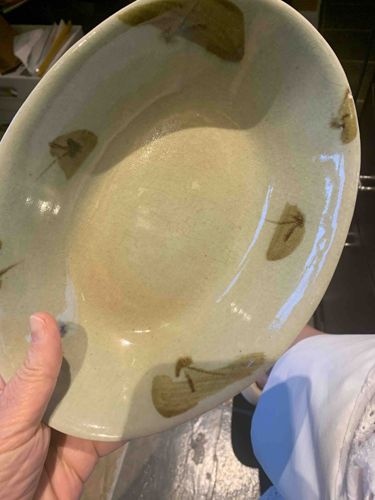
Oval Ceramic Serving Dish with Leaf Motif
This item is an oval-shaped ceramic serving dish or bowl, handcrafted from what appears to be stoneware or earthenware clay. The primary color of the glaze is a muted, pale celadon green or off-white, imparting a soft, natural aesthetic. The glazes exhibit a noticeable crackle finish, a deliberate decorative technique that creates a network of fine cracks on the surface, indicating either a celadon-type glaze or a specific craquelure effect. Scattered across the interior surface of the bowl are stylized organic motifs, possibly leaves or seed pods, rendered in a earthy brown or olive-green pigment. These motifs are somewhat abstract, with outlines or veins hinted at by darker lines. The application of these decorative elements appears somewhat spontaneous and naturalistic, contributing to a rustic or wabi-sabi charm. The bowl features a distinct, integrated handle-like protrusion on one of the shorter ends, allowing for easier handling when serving. The overall construction suggests a hand-thrown or hand-formed origin, indicated by subtle irregularities in the shape and surface. There are no visible chips or major cracks, but surface wear consistent with age and use may be present, particularly within the crackle glaze where dirt or discoloration can accumulate over time. The underside or exterior base is not fully visible, so manufacturing details like maker's marks or signatures cannot be discerned. Based on the aesthetic and glazing technique, the piece likely dates from the mid-20th century to contemporary, possibly influenced by Asian pottery traditions.
AI-Generated Appraisal Disclaimer
Estimated Value
$40-$75
Basic Information
Category
Ceramics/Pottery
Appraised On
December 7, 2025
Estimated Value
$40-$75
Item Description
This item is an oval-shaped ceramic serving dish or bowl, handcrafted from what appears to be stoneware or earthenware clay. The primary color of the glaze is a muted, pale celadon green or off-white, imparting a soft, natural aesthetic. The glazes exhibit a noticeable crackle finish, a deliberate decorative technique that creates a network of fine cracks on the surface, indicating either a celadon-type glaze or a specific craquelure effect. Scattered across the interior surface of the bowl are stylized organic motifs, possibly leaves or seed pods, rendered in a earthy brown or olive-green pigment. These motifs are somewhat abstract, with outlines or veins hinted at by darker lines. The application of these decorative elements appears somewhat spontaneous and naturalistic, contributing to a rustic or wabi-sabi charm. The bowl features a distinct, integrated handle-like protrusion on one of the shorter ends, allowing for easier handling when serving. The overall construction suggests a hand-thrown or hand-formed origin, indicated by subtle irregularities in the shape and surface. There are no visible chips or major cracks, but surface wear consistent with age and use may be present, particularly within the crackle glaze where dirt or discoloration can accumulate over time. The underside or exterior base is not fully visible, so manufacturing details like maker's marks or signatures cannot be discerned. Based on the aesthetic and glazing technique, the piece likely dates from the mid-20th century to contemporary, possibly influenced by Asian pottery traditions.
Get Your Items Appraised
Instant estimates of your treasures with AI-powered instant appraisals